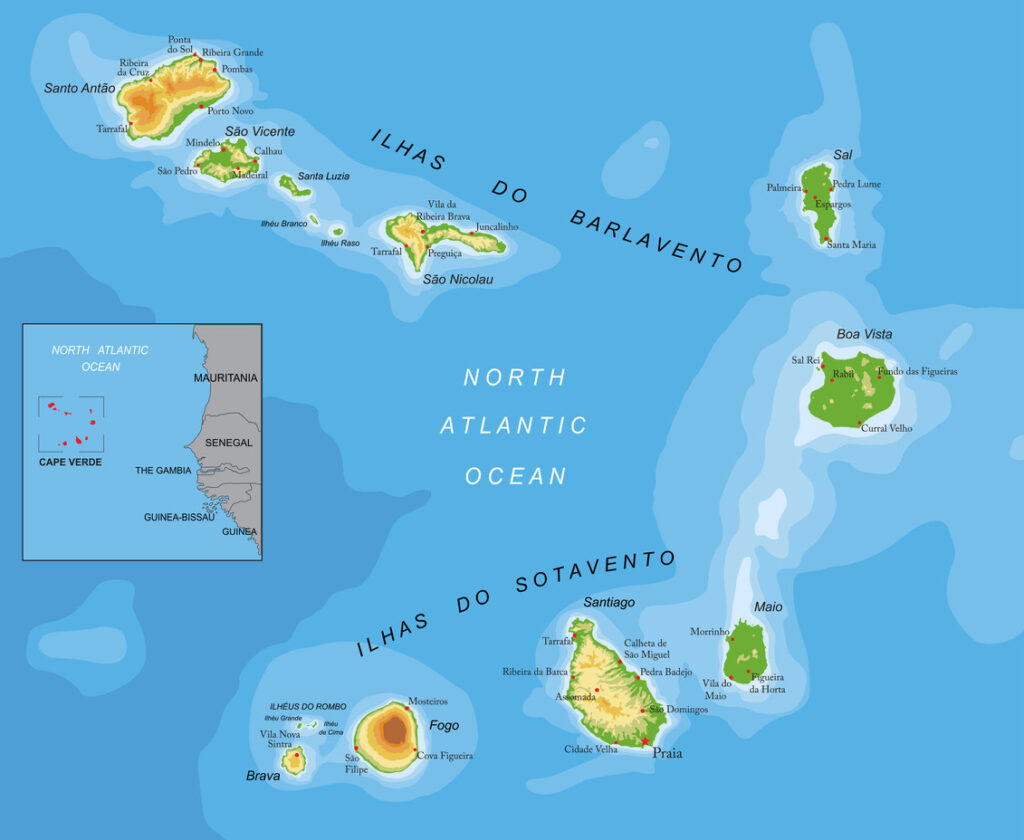Off the coast of West Africa, where the Atlantic Ocean hums quietly between continents, lies a scattered cluster of volcanic islands that few travelers know well—but all who visit never forget.
Welcome to Cape Verde, or Cabo Verde in Portuguese. It’s a place where African roots dance to Caribbean beats, Portuguese colonial echoes linger in cobbled streets, and the horizon seems to stretch into eternity.

A Volcanic Nation With Two Faces
Cape Verde’s geography is a tale of two island groups. To the east, islands like Sal and Boa Vista are low, flat, and sun-drenched, tailor-made for beach lovers, windsurfers, and anyone looking for a simple, sandy escape. Resorts here offer easy comfort, but it’s not hard to wander off and find quiet, empty stretches of shoreline that feel like your own private paradise.
Head west, though, and things change. The western islands—like Santo Antão and Fogo—are greener, cooler, and dramatic. Fogo rises from the sea with the smoky crown of an active volcano, Pico do Fogo, at its center. Coffee grows on its fertile slopes, and villages cling to the edges of old lava flows. Santo Antão is a dream for hikers, all misty mountains, steep ridges, and lush valleys carved with stone terraces.
This contrast is one of Cape Verde’s best-kept secrets. In one trip, you can sip grogue by the beach and trek across ancient calderas, all within a short flight.
So, Where Exactly Is Cape Verde?
Cape Verde sits in a quiet patch of the Atlantic Ocean, west of mainland Africa but politically and geographically part of the African continent. It’s a member of the African Union and shares deep cultural ties with countries like Senegal and Guinea-Bissau. But its former life as a Portuguese colony left lasting marks—visible in the architecture, language, and lifestyle.
You can reach Cape Verde directly from several European cities in just 4 to 6 hours. That makes it a go-to escape for European travelers looking to trade city noise for ocean breeze without crossing half the world.
Music, Morna, and Mindelo Nights
Cape Verdean culture is as layered as its terrain. The islands are Creole in the truest sense—a blend of African, Portuguese, and Brazilian influences that shape everything from music and dance to language and food.
If there’s one place that captures this spirit, it’s Mindelo, the cultural capital on the island of São Vicente. It’s where Cesária Évora, the barefoot queen of morna, gave voice to the soulful heart of the islands. Walk its cobblestone streets and you’ll hear music everywhere—from bars and restaurants to festivals that spill into the streets.
And it’s not just morna. Cape Verde also pulses with funaná, coladeira, and batuque—sounds that reflect joy, resilience, and centuries of migration.
Island-Hopping the Archipelago
Each of Cape Verde’s ten main islands has something special to offer. Here’s a glimpse:
- Sal and Boa Vista: Flat, dry, and lined with white sand beaches. These are the go-to spots for easy holiday vibes and water sports.
- Santo Antão: A hiking paradise with deep green valleys and epic ridgelines. It’s where nature lovers feel most alive.
- Fogo: Home to the country’s highest point, this island is raw and volcanic—ideal for adventurers and wine lovers.
- São Vicente: Come for the culture, stay for the music. Mindelo is the creative heartbeat of Cape Verde.
- Santiago: The largest island and home to the capital, Praia. It’s where urban life, history, and tradition all intersect.
- Brava, Maio, São Nicolau, and Santa Luzia: Quieter, less touristy, and perfect for travelers looking to get off the beaten path.
Life in Praia, the Capital City
Cape Verde’s capital, Praia, is perched on the southern coast of Santiago island. It’s not a flashy city, but it’s full of character. The Plateau—the old colonial heart of the city—offers views over the Atlantic and a mix of government buildings, old churches, and lively markets.
The city has grown fast in recent years, but it still moves to its own rhythm. Locals gather on beaches like Quebra Canela in the evenings, children play football as the sun sets, and the sound of music floats through the warm air.
Why Cape Verde Feels Like a Secret Worth Keeping
Yes, Cape Verde has world-class beaches. Yes, the weather’s good all year round. But what really makes it stand out is how real it feels. There’s no overwhelming tourism machine here. People still live at the pace of island life. Fishermen still go out at dawn. Grandmothers still cook cachupa over wood fires. And strangers still say hello on the street.
It’s remote without being isolated. Exotic without being inaccessible. And while it’s no longer completely unknown, it still feels like a secret—a rare thing in today’s travel scene.
So if you’re looking for a destination that gives you sun, soul, and scenery in equal measure, keep Cape Verde on your radar. Or better yet, book the flight and see for yourself why it’s one of Africa’s hidden Atlantic gems.


What’s up it’s me, I am also visiting this web site regularly, this
web page is really pleasant and the users are actually sharing good thoughts.